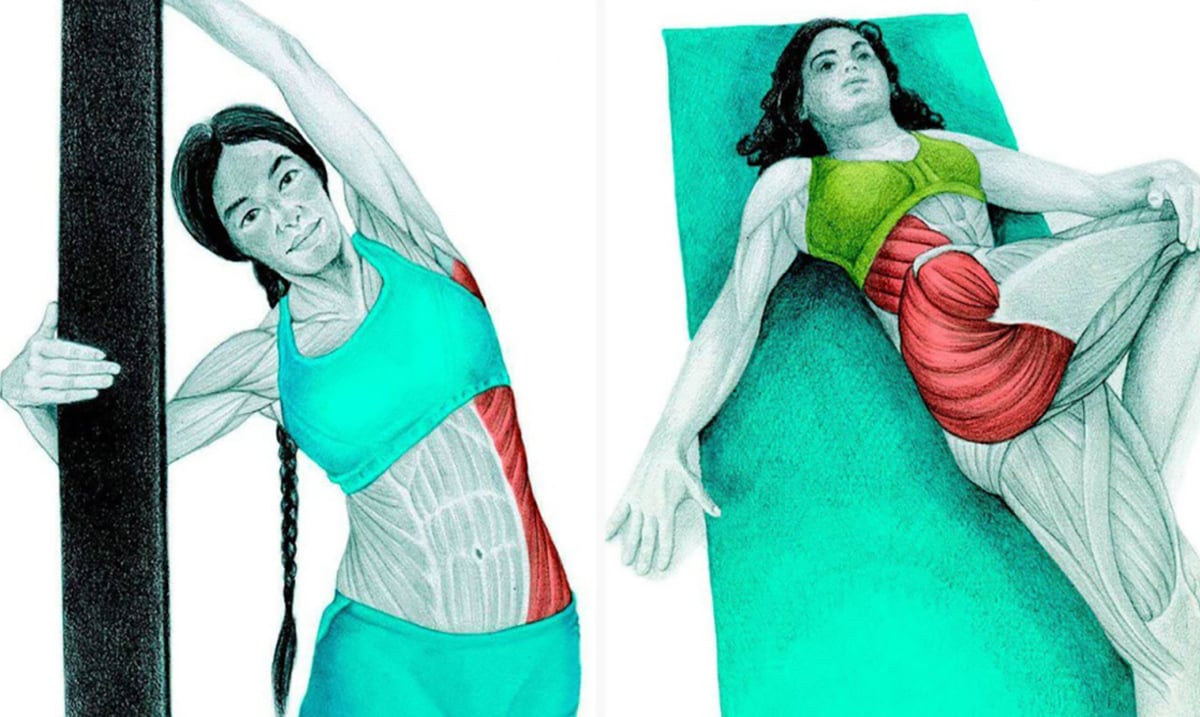The popularity of yoga in the United States is on the rise, with approximately 9.5% of Americans reporting that they have added yoga into their routine. With benefits ranging from improved flexibility and muscle tone to reduced stress and mental illness, yoga has allowed Americans to become more in tune with their bodies than ever before.
As a society, Americans are starting to acknowledge the need to prioritize our health and well-being, pushing for the availability of healthier food options at all of our favorite restaurants, and investing money in exercises classes and fitness trackers to improve our level of physical activity. However, are we merely chasing a trend or are we truly educating ourselves on the way that our bodies work, and how to optimize our physical and mental health?
Yoga expert and author of ‘Encyclopedia of Pilates Exercises’ Vicky Timon made it her mission to help educate all who wanted to learn about the muscular structure of the human body, and which muscles are activated during the practice of various yoga techniques. She illustrated a series of 34 pictures, captioned with the assistance of James Kilgallon, CSCS, creator of Mazlo’s Body Maintenance Program. Together, the two have provided an incredible resource.
There are approximately 700 muscles in the human body, responsible for every little movement and the function of every major organ including the heart, digestive system, and brain. Each of these muscles serves a specific and important purpose. Stretching and strengthening your muscles can help you to feel better, lose weight, improve your posture and prevent aches and pains.
Check out this incredible guide by Vicky Timon and James Kilgallon, illustrating the impact of yoga on your muscles:

#1 – Camel Pose
“Muscles Highlighted: Rectus Abdominus and External Obliques. This stretch is best reserved for people who have good flexibility already. Sit on your heels and place your hands behind you as you push your hips up and forward. Avoiding putting too much pressure on your lumbar spine. If you have neck problems do not drop your head back.”
#2 – Wide Forward Fold
“Muscles Highlighted: Adductors. This is a great exercise to open the hips, and stretch the adductors and hamstrings. Start this stretch with your knees bent, and spine straight. As your muscles begin to release you can slowly straighten your legs, round out your back and reach for your feet. Lightly pull on the bottom of the balls of your feet to release the calf muscles as well. If you can not reach your feet you can use a belt or towel. You can also perform this stretch lying on your back with your feet going up the wall.”
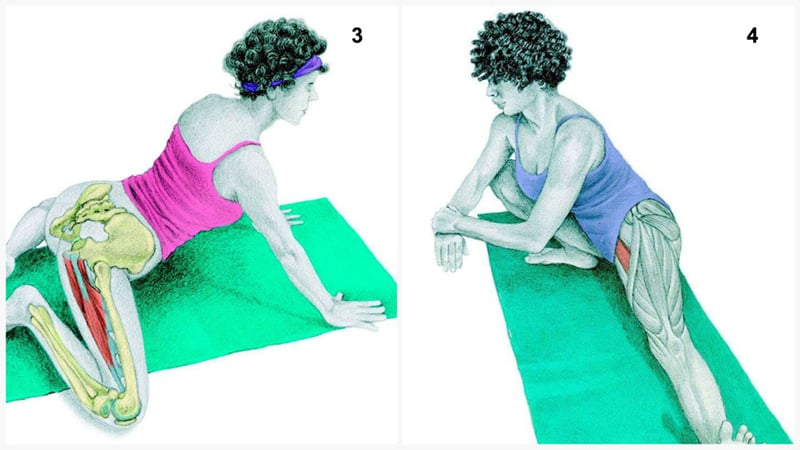
#3 – Frog Pose
“Muscles Highlighted: Adductors. This is a deep groin stretch that can place pressure on your knees so it’s helpful to be on a soft surface. Start by resting on your hands and knees and slowly bring your knees wider until you feel a good stretch in your groin muscles. You will feel slight variations in the stretch as you actively push your hips back and forward.”
#4 – Wide Side Lunge Pose
“Muscles Highlighted: Adductors. Start with both feet forward in a wide stance with your legs as straight as possible. Slowly walk your hands to your right foot while bending your right knee and rotating your left toes up to the ceiling, sitting into your right hip. Keep your right foot flat on the ground.”
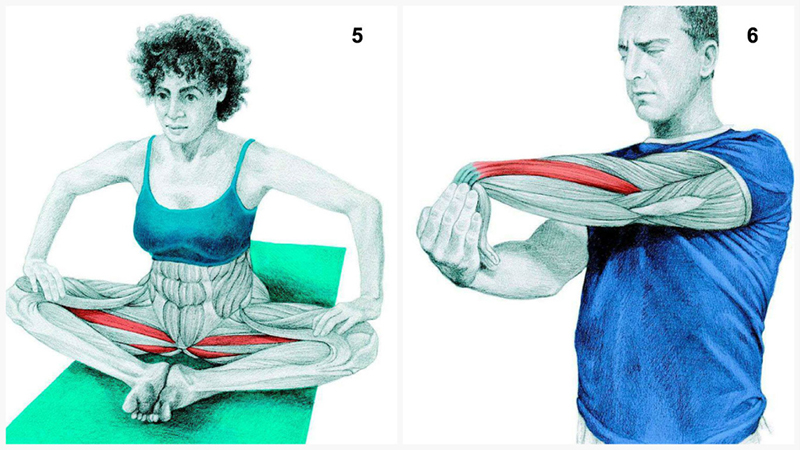
#5 – Butterfly Stretch
“Muscles Highlighted: Adductors. Start in a seated position and bring the soles of your feet together and sit tall through your sit bones. Progress this stretch by placing pressure on your knees with your hands. The closer your feet are to your body the more you will stretch your groin muscles. Bring your feet farther from your hips and slowly round your upper body to release your back muscles.”
#6 – Forearm Extensor Stretch
“Muscles Highlighted: Forearm Extensor. Start by packing your should down and back, then externally rotate the shoulder for the optimal position to stretch the forearm muscle. Once in this position apply pressure to your opposing hand to begin the stretch. You can progress this stretch by touching the tips of your fingers together in a tea cup shape.”
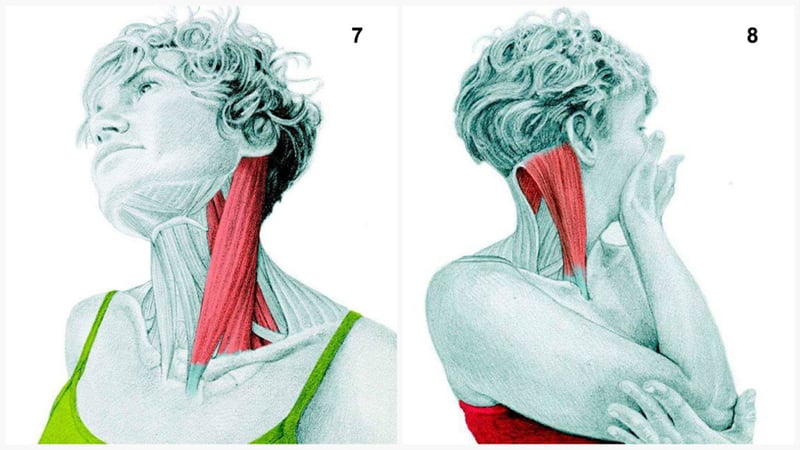
#7 – Lateral Side Flexion of the Neck
“Muscles Highlighted: Sternocleidomastoid “SCM”. Try to keep your neck as long as possible while slowly dropping your ear to your shoulder, making sure you are not collapsing your cervical spine. You can progress this stretch by being seated on a chair and grabbing the bottom of the seat. This will help you create consistent tension down the arm and neck which will allow you to target the upper traps.”
#8 – Neck Rotation Stretch
“Muscles Highlighted: Sternocleidomastoid “SCM”. Start by slowly rotating your neck, while keeping your chin slightly elevated to isolate the SCM. If you would like to get a deeper stretch apply pressure with the opposite hand from the direction that you are rotating.”
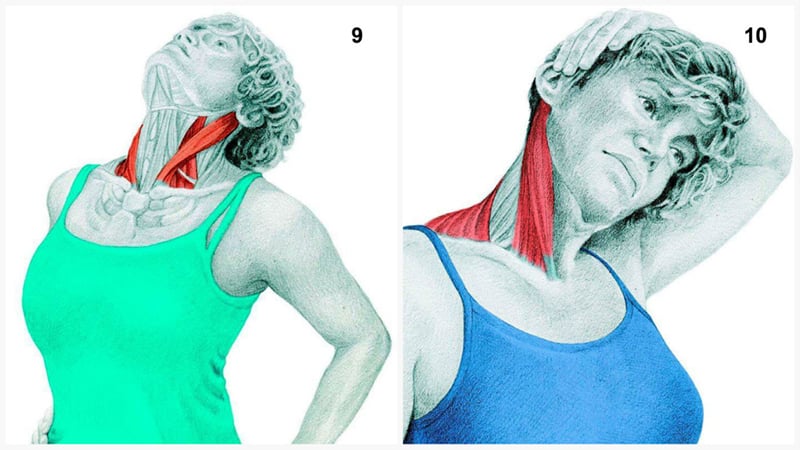
#9 – Neck Extension Stretch
“Muscles Highlighted: Sternocleidomastoid “SCM”. Start by placing your hands on your hips, while keeping your spine long start to tilt your head back, making sure you are not collapsing your cervical spine.”
#10 – Lateral Side Flexion of the Neck with Hand Assistance
“Muscles Highlighted: Sternocleidomastoid “SCM” and Upper Trapezius. Try to keep your neck as long as possible while slowly dropping your ear to your shoulder, making sure you are not collapsing your cervical spine. You can progress this stretch by being seated on a chair while grabbing the bottom of the seat. This will help you create consistent tension down the arm and neck which will allow you to target the upper traps.”
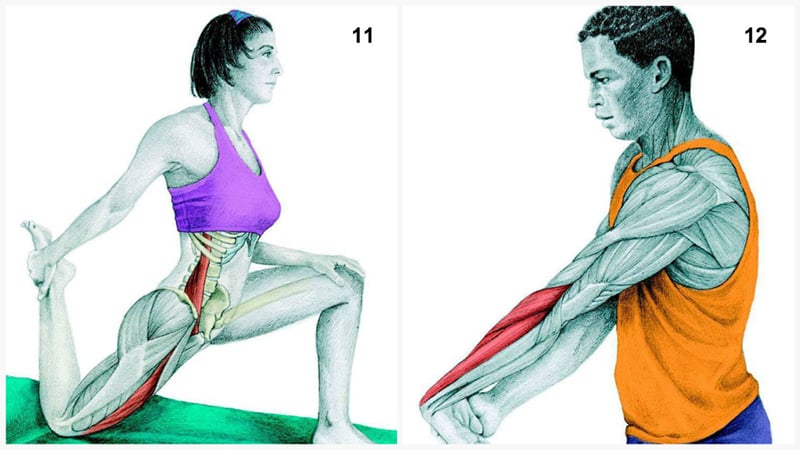
#11 – Half Kneeling Quad / Hip Flexor Stretch
“Muscles Highlighted: Psoas and Quadracep. Start in a half-kneeling position. As you slowly bring your right hip forward you should begin to feel a stretch in the front of your hip. Grab your back foot and squeeze your back glute to increase the stretch on your Hip Flexors.”
#12 – Forearm Extensor Stretch
“Muscles Highlighted: Forearm Extensor. Start by packing your shoulder down and back, then externally rotate the shoulder for the optimal position to stretch the forearm muscle. Once in this position apply pressure to your opposing hand to begin the stretch. You can progress this stretch by touching the tips of your fingers together in a tea cup shape.”
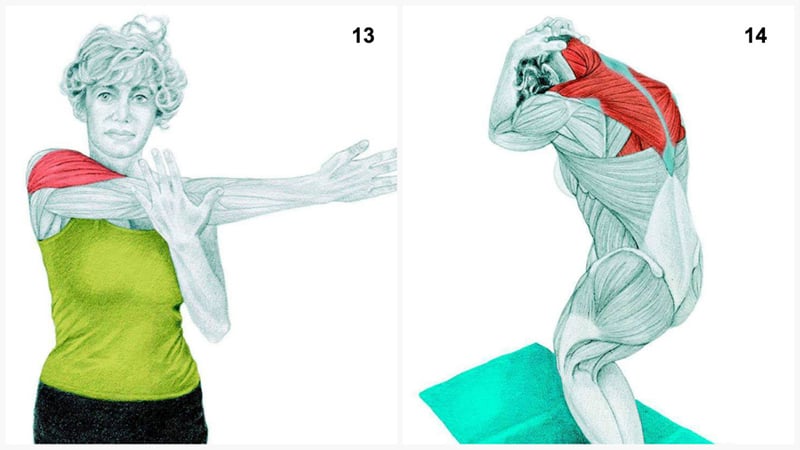
#13 – Lateral Shoulder Stretch
“Muscles Highlighted: Side Deltoid. Bring your arm across your body and lightly apply pressure to your arm to increase the stretch on your shoulder.”
#14 – Standing Assisted Neck Flexion Stretch
“Muscles Highlighted:Trapezius Muscle. Start by standing with your feet together. Keeping your spine long, slowly sit your hips back and round your upper back, tucking your chin to your chest at the same time.”
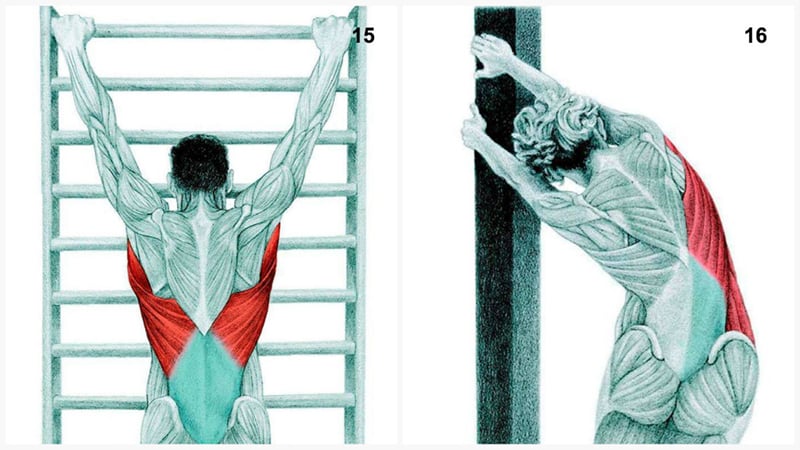
#15 – Lat Stretch with Spinal Traction
“Muscles Highlighted: Latissimus Dorsi. Start by taking a firm grip on bar, then slowly lift your feet off the ground. You should feel a stretch in your lats and chest. If you take your feet completely off the ground you will feel traction in your lumbar spine. Avoid this stretch if you have recently injured your shoulder, and/or have impingement of the shoulder.”
#16 – Lat Stretch at the Wall
“Muscles Highlighted: Latissimus Dorsi. Start by placing both hands on the corner of a wall or post. While keeping your spine long, slowly push your hips out to the side. Avoid this stretch if you have lower back problems.”
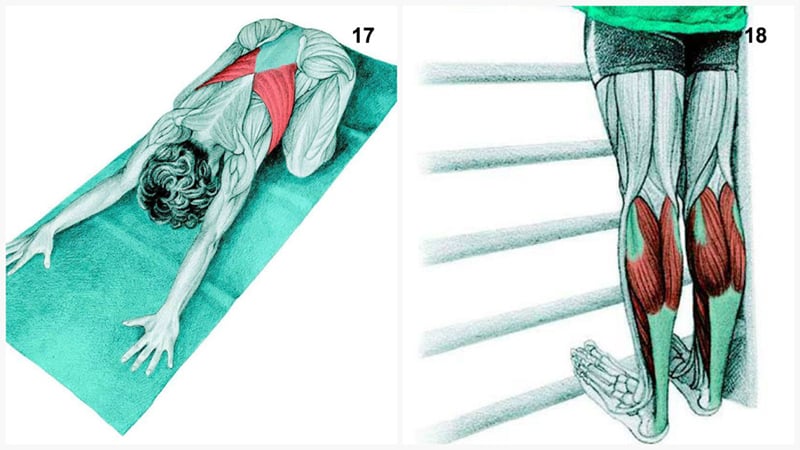
#17 – Child’s Pose
“Muscles Highlighted: Latissimus Dorsi. Start on your hands and knees then slowly bring your hips back until your forehead is on the floor. You can bring your knees wider to get a better stretch in your hips. Arch your upper back and externally rotate your shoulders to stretch your lats and chest muscles.”
#18 – Standing Calf Stretch
“Muscles Highlighted: Soleus and Gastrocnemius. You can perform this stretch on a rack or on the edge of a stair step. Lightly rotate your ankles internally and externally to actively stretch the calf muscles.”
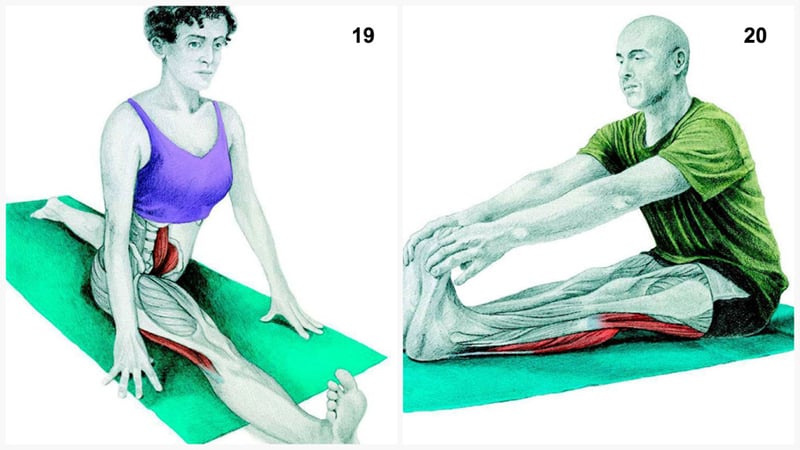
#19 – Front Split
“Muscles Highlighted: Psoas and Hamstring. This is an advanced stretch, proceed with caution if you have any hip problems. Start in a kneeling lunge position, it can also be helpful to have the support of a chair as your hip flexors and hamstrings release.”
#20 – Seated Forward Fold / Seated Toe Touch
“Muscles Highlighted: Hamstrings and Calfs. Start by sitting into your sit bones and bend the knees if needed. As your flexibility improves your legs will naturally straighten. If you have back problems keep the spine as straight as possible. You can also perform this stretch lying on your back with your feet up a wall.”
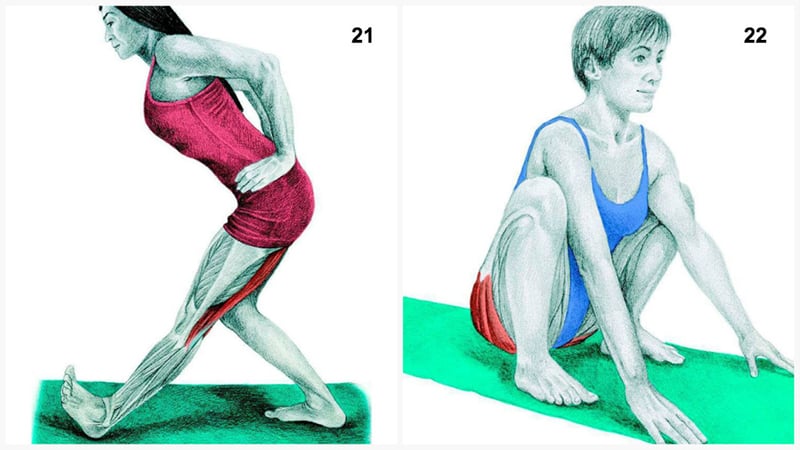
#21 – Single Leg Forward Bend
“Muscles Highlighted: Hamstrings. Start this position with one foot in front of the other. Bring your hands to your hips and while keeping the back straight, begin to bend from the hips.”
#22 – Deep Squat
“Muscles Highlighted: Glutes. This movement has a global effect on all areas of your body. If you have bad knees, or cannot keep your heels on the ground, practice your squat before proceeding. Start by standing with your feet shoulder width apart then slowly lower yourself into the deep squat. Once in position bring your arms inside your legs and lightly apply pressure to the inside of your knees, sitting into the hips and heels. You can also practice this position lying on your back with your feet against a wall.”

#23 – Seated Half King Pigeon Pose
“Muscles Highlighted: Glutes. Start in a seated position slowly pull your leg to your chest and externally rotate your hip while keeping your spine straight. You should feel this stretch in your glute.”
#24 – Standing Calf Stretch at the Wall
“Muscles Highlighted: Soleus and Gastrocnemius. Start out in a lunge position with your back foot slightly turned out. Slowly bring your back heel to the ground to stretch your calf muscles.”
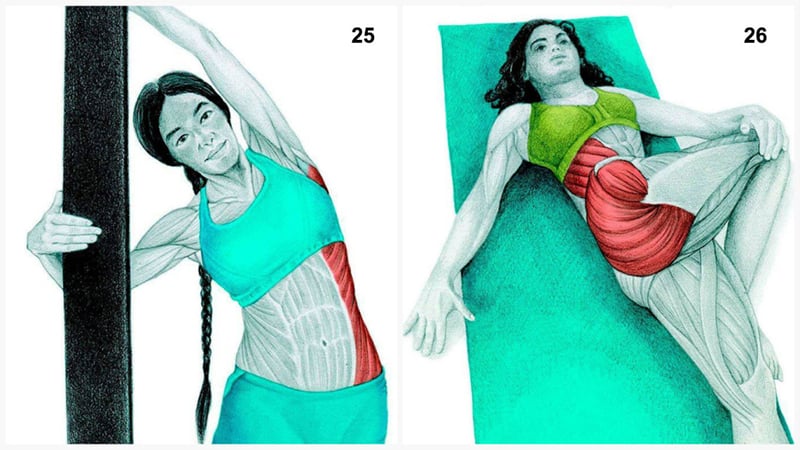
#25 – Lateral Flexion at the Wall
“Muscles Highlighted: External Obliques. While keeping your spine long slowly push your hips out the side. Avoid this stretch if you have lower back problems.”
#26 – Supine Twist
“Muscles Highlighted: Glutes and External Obliques. This is a great stretch for those trying to manage Sciatic Pain. Start by lying flat on your back then bring one leg across your body, slowly rotating your gaze and upper body in the opposite direction. The key to this stretch is using your breath to open up your rib cage and sacroiliac joint and hip area without placing too much pressure on the lower back. If you find this stretch to be too difficult you can stack both of your knees on top of each other. Once in this position, you will feel more of a stretch on the upper spine when the knees are higher, and more of a stretch on the lumbar spine when the knees are lower.”

#27 – Lateral Flexion with a Dowel
“Muscles Highlighted: External Obliques and Latissimus Dorsi. With your spine long, slowly push your hips out to the side while keeping your shoulders externally rotated. Avoid this stretch if you have lower back problems.”
#28 – Triangle Pose
“Muscles Highlighted: External Obliques. Start with a wide stance with your front foot straight ahead, and your back foot at 90 degrees. Place your hand on your front leg or floor as you sit back into your front hip with a straight back. As you rotate away from your front leg keep your gaze on the hand that is in the air.”

#29 – Chest Stretch at the Wall
“Muscles Highlighted: Pectorals. Start by facing the wall with your thumb up. Slowly rotate away from the wall to stretch your chest muscle. You should feel this stretch in the belly of the muscle. If you feel it in the shoulder joint you are stretching too far.”
#30 – Assisted Chest Stretch
“Muscles Highlighted: Chest and Latissimus Dorsi. Start by lying on the floor with your palms facing up. As you partner sits into a deep squat you should feel a stretch in your chest and lats. You will also get some traction in your spine from the stretch. Avoid this stretch if you have impingement of the shoulder.”
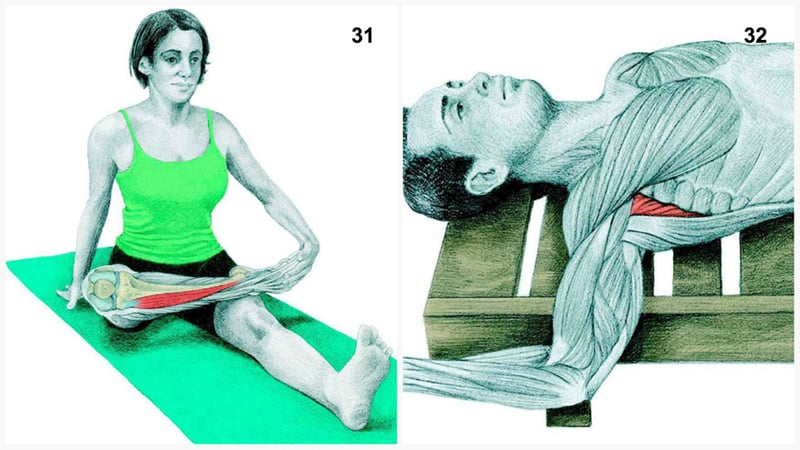
#31 – Seated Half Pigeon Variation
“Muscles Highlighted: Anterior Tibialis. Start by sitting with your feet in front of you. Bring one hand behind you as you externally rotate your hip and bring one foot above your knee. To increase the stretch on your hip slowly lean forward, initiating the movement by hinging at the hips.”
#32 – Supine Shoulder External Rotation Stretch
“Muscles Highlighted: Subscapularis. Start by lying flat on your back, bring your arm straight out to the side with your elbow at a 90-degree angle. Slowly bring the back of your hand to the floor. If you hand is far away from the floor it means your rotator cuff and other muscles that control internal rotation are tight.”
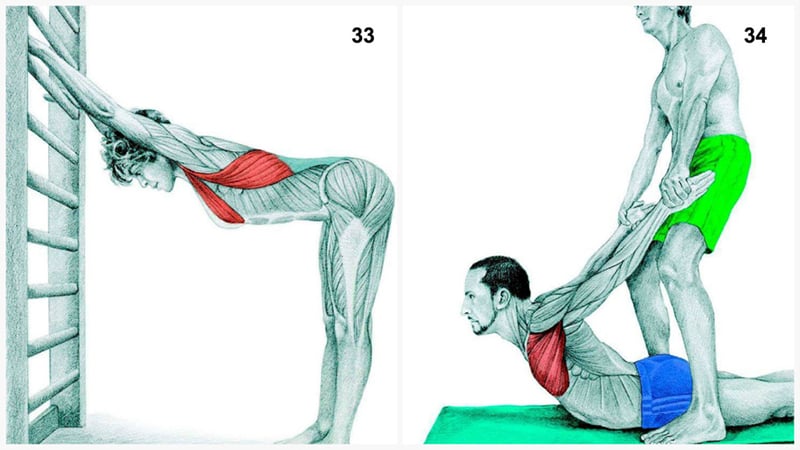
#33 – Down Dog Variation at the Wall
“Muscles Highlighted: Pectorals and Latissimus Dorsi. Position yourself far enough from a wall or rack so that when you touch the wall your body becomes parallel to the ground. Move into this position by hinging at the hips and keeping your spine straight. Once in position, push your chest forward creating a slight arch in your upper back, stretching your lats and chest muscles. If you have tight hamstrings try bending at the knees.”
#34 – Assisted Chest Stretch Variation
“Muscles Highlighted: Pectorals. Start by lying face down on the floor with your palms facing down. As your partner pulls back on your hands you will feel a deep stretch in your chest muscles. Avoid this stretch if you have impingement of the shoulder.”

